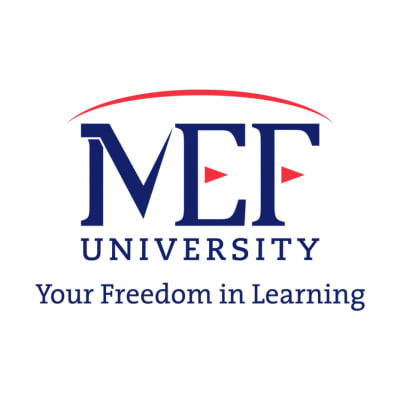
MEF University

Introduction
Knowledge and Experience of 47 Years
MEF University, which admitted its first students in the academic year 2014-2015, aims to become a university that keeps entrepreneurship, innovative thinking and creativity in the foreground and has the ability to create global and local value-added with its distinctive educational model.
Vision and Mission
Vision
Educate innovative and entrepreneurial global leaders to shape the future.
Mission
Graduate forward-thinking students who possess the ability to compete at the national and international level and to associate their national identities with global values; who continuously improve themselves, master technology, act respectfully towards the environment, respect societal and ethical values; who possess the ability to combine and apply their creativity, entrepreneurship and leadership qualities with their research competencies so as to break new grounds in the national and international arenas,
Bring together and support research-oriented, leading scholars who will make globally significant contributions to their professional fields, science, and technology,
Establish and sustain the necessary infrastructure and inspiring environment for the faculty, students and staff to make these targets achievable.

The Foundation Behind Us
As leaders in quality education in Turkey with their national and international schools, the MEF Educational Institutions’ fundamental objective has been to strengthen their lasting mission in the field of education with a university.
The MEF Educational Institutions have created a difference in education with their accumulation of knowledge and experience of 43 years, and MEF University was established by the İbrahim Arıkan Education and Scientific Research Foundation with the aim to carry on this success at the level of higher education.
MEF University, which admitted its first students in the academic year 2014-2015, aims to become a university that keeps entrepreneurship, innovative thinking and creativity in the foreground and has the ability to create global and local value-added with its distinctive educational model.
MEF University has completed all of the necessary preparation to become a university that can respond to the requirements of the current century, have its diploma recognized worldwide, and hold a place of high esteem with its international academic and administrative organization, dynamic and accessible management approach and its innovative and environmentally-conscious approach in creating its physical infrastructure.

Campus Life
MEF University's campus is located in Maslak, the financial and commercial hub of Istanbul. The campus is conveniently located within walking distance of the ITU Maslak Metro Station. The campus where students can meet all of their daily needs provides many opportunities for an enriched student life and an accessible platform for culture and arts located right next to the campus will enable students to experience a quality of life that goes beyond the beliefs. Our students will be able to keep up with cultural and artistic events thanks to the complex next to the campus and they will also have the opportunity to get to know local business life thanks to the important and central location of Maslak. With its modern classrooms and areas for social life, MEF University Maslak Campus is awaiting you.
Flipped Learning
Rapidly advancing Information technology is encompassing and changing all aspects of our lives from how we interact with each other, the way we read books, the way we order food, how we come together for a business meeting. Why should not our way of learning change too?
What is Flipped Learning?
Eric Mazur, a Physics professor at Harvard University, defines learning as a two-step process. The first step is knowledge transfer (transmission of knowledge from the source of knowledge to the student by means of their professor and different resources) and the second one is the internalization of knowledge by the student.
In the traditional education system, faculty members are given the easy task of transferring knowledge to students in the classroom, while students face the difficult task of completing assignments and internalizing knowledge alone. In the Flipped Learning model, knowledge transfer to students takes place prior to the class through course videos prepared by the faculty members and supporting materials such as articles, Excel sheets, pdfs, visuals, images, and PowerPoints. This means that the direct instruction moves from the group learning space to the individual learning space. The resulting group space is transformed into a Flipped Learning environment which is dynamic and interactive where the professor guides students as they apply concepts and engage creatively in the subject matter. This allows students to internalize and develop their knowledge – the real essence of being a learner – in the classroom in collaboration with the professor and classmates.
Why is the Flipped Learning System Needed?
People born after the introduction of internet technology, which is now everywhere in our daily lives are much faster than the previous generations in catching up with the digital world and what it encompasses. One of the best examples of this is the story from 25 September 2006 of a 3-year-old getting online on the computer at home and managing to buy a car as the mother had forgotten to log out from her internet account, (BBC News). Generations Y and Z have grown up independent-minded, intertwined with technology, communicating easily with their peers around the world, and keeping abreast with the new technological tools that appear and disappear quickly. It has to be accepted that it has become impossible to educate the new generations of the future with a 900-year-old traditional university system. For this reason, MEF University has implemented a new teaching method called “Flipped Learning”. In the world where entire life is dominated by digital technology, Flipped Learning is a method globally emerging to target educating the current Generation Y students and the university students of the future in Generation Z and later.
The Flipped Learning method is well-aligned with Bloom’s Taxonomy, as the students carry out lower-level cognitive tasks such as acquiring, remembering and understanding information prior to class hours, and focus on higher-level cognitive tasks – applying, analyzing, evaluating and creating – during the class in an environment of peer learning facilitated by their professors.
How does Learning Take Place in Flipped Learning?
In Flipped Learning, learning takes place in the following ways:
- Students watch course videos, read texts and study materials at their convenience prior to the class, take notes, prepare questions about issues they did not understand or did not understand well.
- The students send their questions on the class topic(s) to the professor digitally before the class.
- The students are grouped as per the nature of the questions during the first class. The students try to seek answers to their questions through group work and peer learning. The proffesor monitors the groups and facilitates the problem-solving.
- In the second hour of the class, the professor facilitates the learning in such a way as to encourage students to answer the questions that remained unanswered.
- The professor asks questions in order to check the understanding of the concepts by the students or has students work in teams on problems that concern the more practical or applied aspects of the topic.
- This model enables students to transition from “people who are fed knowledge by their professors” into “people who discover the knowledge and take the acquired knowledge one step further.”
Why is Flipped Learning Better for the Students?
- Students learn, revise and review the course material at their own pace.
- Each student has a different learning style. In the traditional method, the professor cannot respond or relate to all of these styles. Flipped Learning enables students to watch the lecture on video at his/her desired speed, stop, rewind and replay it if necessary.
- Since the lessons are structured in an interactive, reciprocal and applied way, it is easier for students to grasp the topics.
- Students do not remain passive in the class as they are truly in charge of their own learning through teamwork; all students naturally participate in the activities.
- Students co-generate new knowledge through collaboration and discussion.
- Students who miss a class due to medical reasons or due to the required sport and student club activities are not left behind.
- Students still have a minimum of 2 hours /week office hours with their instructor, one hour of which will be online. Communication with the faculty member is maintained.
- Course materials are always available on the platform. The students may revisit previous content and review them whenever needed.
- There is more interaction and personal contact between the student and the faculty member.
- Students have more responsibility for their own learning; all students are active in the classroom.
- All students receive one-to-one, personalized instruction.
- Lower level cognitive tasks, such as remembering and understanding, are carried out prior to the class hours, and students concentrate on the higher-level cognitive tasks – applying, analyzing, evaluating and creating – during the class hours through peer learning facilitated by their professor.
Why is Flipped Learning So Successful?
- It increases student engagement.
- It enables students to become more learner-centered.
- It encourages critical thinking.
- It improves team-based skills and collaboration.
- It offers more personalized student guidance.
- It makes classroom discussion more effective.
- It encourages students to self-reflect.
- It provides an instructor and peer feedback.
- It holds students accountable for their own learning.
- It encourages learning through up-to-date technologies relevant to Generation Y and Z students.
Programmes
- Bachelor of Arts in Business Administration
- Bachelor of Arts in Economics
- Bachelor of Arts in Political Science and International Relations
- Bachelor of Arts in Psychology
- Bachelor of Science in Architecture
- Bachelor of Science in Civil Engineering
- Bachelor of Science in Computer Engineering
- Bachelor of Science in Electrical-Electronics Engineering
- Bachelor of Science in Industrial Engineering
- Bachelor of Science in Mechanical Engineering